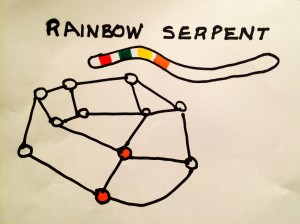 by Mike Fellows and Frances Rosamond
by Mike Fellows and Frances Rosamond
Colouring a graph properly (no adjacent vertices can receive the same colour) is important in scheduling (classrooms, jobs, exams, resources). The vertices represent the jobs. An edge between two vertices indicates a conflict. Colours are the timeslots. Two jobs cannot be assigned the same timeslot or else they will be in conflict (both rely on a shared resource, for example).
Colouring a graph leads us to a Rainbow Serpent story. The snake has colourful stripes like a rainbow. Like a rainbow, no two colours are repeated (i.e., no two adjacent stripes have the same colour). Rainbow Serpent likes to be present and observe everything, but remain hidden. Sometimes the Rainbow Serpent will surface to talk to the people and teach them. The vertices on the graph represent places where the snake might be. If two adjacent vertices are coloured the same, then we know the snake is not there. In order to see Rainbow Serpent, colours must not be repeated.
In discussions at the First International Conference on Creative Mathematical Sciences held in August 2013 in Darwin, AU (www.cdu.edu.au/conference/csmaths), we discussed how to relate Culture-Story with Mathematics. We see two useful directions.
1) Choose a mathematical topic, such as graph colouring. Relate the mathematics to known cultural story, as in the Rainbow Serpent puzzle.
2) Choose a cultural story, such as “Wirroowaa white clay and the giant kangaroos.” It can introduce cryptography as Wirroowaa cover himself in white clay to camouflage, so he is encrypted and the giant kangaroos cannot see him. This is suggested by Vladimir Estivill-Castro, who found the story on http://austhrutime.com/giant_kangaroos_dreamtime.htm
Stay tuned to CSMaths.org as we develop more Culture-Story-CSMath connections.